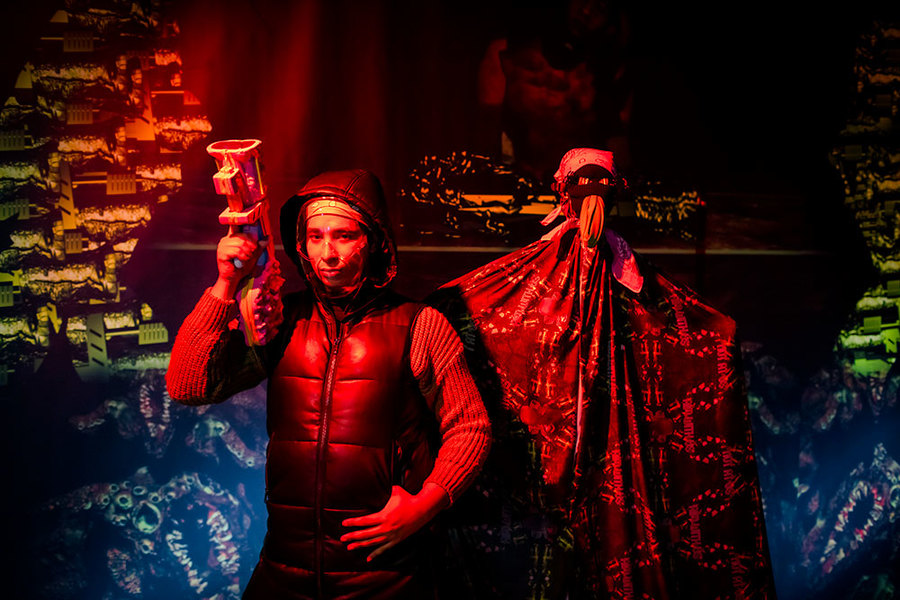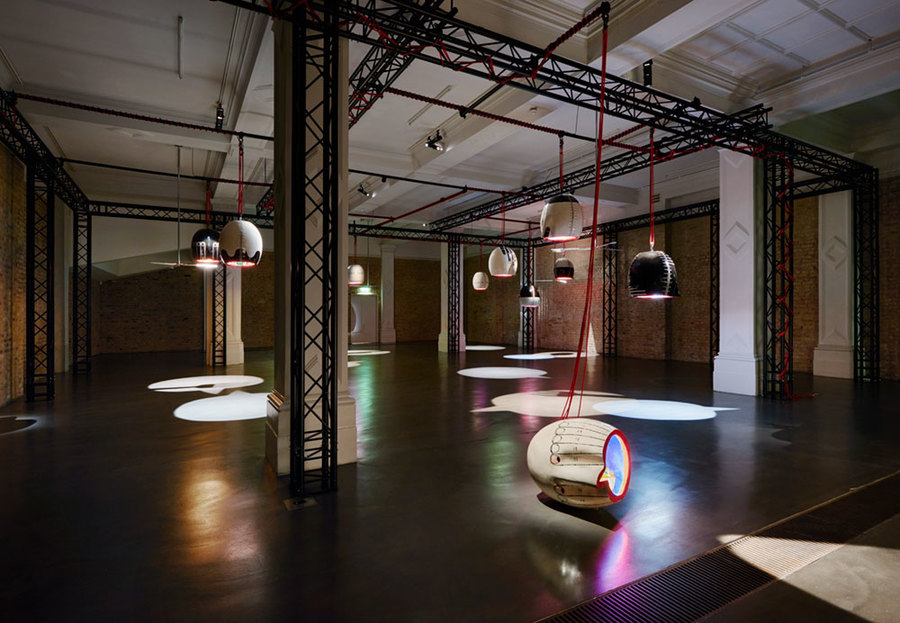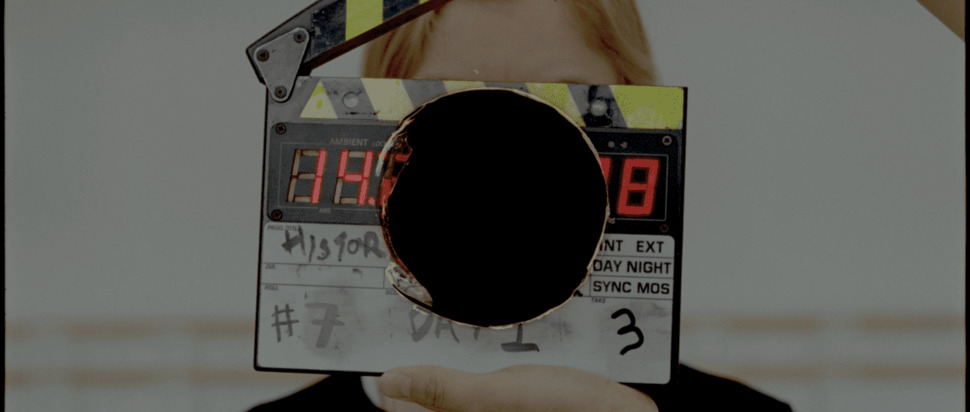Present Tense: Art Night Dundee 2023
In the lead up to Art Night in Dundee, we speak to Maria Fusco, Margaret Salmon and Annea Lockwood about their commission: an opera-film titled History of the Present
On the 25th anniversary of the Good Friday Agreement, as police lined the streets of Belfast and world leaders amassed at Queen’s University to commemorate the agreement which sought to end The Troubles, the opera-slash-film History of the Present premiered around the corner. Titled to reflect the “‘present-tense-ness’ of collective and personal trauma", it is similarly clear from Belfast’s defence architecture that the city still lives and breathes the effects of The Troubles: steel security gates close in the evenings and throughout the day on Sundays to separate nationalist communities from the unionists.
During the premiere of History of the Present, these ‘interfaces’ closed. The peace lines, some paradoxically dressed with razor wires and others painted with colourful murals, stand still and upright, cutting through communities. Reflecting on the existence of these peace walls, Annea Lockwood’s first question to Maria Fusco at the film’s screening was: "When the wind blows, do the peace walls make sounds?"
Opera might strike some as an unusual medium to forefront working class women’s voices. Yet, in countries like Italy, Fusco notes that the art form is “more integrated into everyday people’s lives.” The Belfast-born writer saw in opera “the capacity to hold and share complex emotional registers in non-representational ways.” She reminds us that History of the Present is not strictly limited to the opera form: it’s recorded on 35mm film, too. The voice and sound that is so integral to History of the Present speaks to Fusco’s oral memories of The Troubles as a wee child. She grew up beside a peace line and when riots broke out, she and her family took shelter inside, distancing themselves from eyeshot but still within earshot. Recordings from Fusco’s childhood have been incorporated into the opera film; most notably, a clip from when she was learning how to speak by following the notes of her mother’s voice without understanding the meaning behind the words.
In contrast to the amateur nature of childhood recordings, Annea Lockwood collaborated with the Sonic Arts Research Centre at Queen’s University. Using microphones designed to pick up vibrations from all sorts of surfaces, initially Lockwood’s team made “gorgeous” recordings of the traffic along the peace lines to sonically ground History of the Present. When Lockwood returned to Belfast, she learned “how to play the walls [...] like [...] an instrument.” This kind of sonic improvisation is epitomised in Héloïse Werne’s soprano voice – as the only identifiable figure in the opera-film, noise viscerally reverberates through her. The libretto is equally formidable. Fusco points us towards one line in particular: “our futures are a matter of seconds.” Unpacking this, she sheds light on the disjointed passage of time for those who have grown up during The Troubles or experienced living in a conflict zone. “History [...] casts a long shadow into an individual’s future,” she reflects, “time can become confused and confusing.”
Like a phantasmagoria, History of the Present makes use of split screens, double exposure and blurring – cleverly achieved by smeared Vaseline across the camera lens. Early on in the process of making the work, Fusco pulled in the filmic expertise of Margaret Salmon. In her experimental approach to filmmaking, Salmon was conscious not to “extract images” from Belfast. Instead, her process was elaborately site-specific; she spent time getting to know certain areas of the city and the people who live there. Only when Salmon felt familiar with the site on her third visit, did she start to film. Collaboratively, Fusco and Salmon were determined not to lean into the visual landscape of Belfast (which would have been “easy to reproduce”), so as to avoid visually duplicating archival footage from The Troubles, which has been broadcast on countless occasions.
Art Night Dundee highlights
History of the Present is just one of a plethora of artworks commissioned for this rendition of Art Night, taking place across Dundee on 24 June. Elsewhere, exhibitions, performances and screenings will unravel across the city’s traditional venues, but also in some unexpected locations. Saoirse Amira Anis, who is based in Dundee, will present a series of dynamic performances that respond to their current exhibition symphony for a fraying body, which is currently on display at Dundee Contemporary Arts. Drawing on watery mythologies from Scotland and Morocco, the amphibious creature that features in the film at DCA will emerge from the screen and break free from the gallery as it seeks the waters of the River Tay. Traces of Anis’s exhibition at Dundee Contemporary Arts will inhabit the deck of the HMS Unicorn in Dundee’s harbour, and will be open to view until the final segment of the performance. Breach of a fraying body will start at DCA at 7pm before moving through the city in a carnival-like procession, finishing around 11pm at the HMS Unicorn.

Danielle Brathwaite-Shirley. Photo: Dan Weill Photography
Taking place across two venues, Danielle Brathwaite-Shirley’s THE LACK: I knew your voice before you spoke asks Art Night’s audiences to collaboratively imagine new worlds together. In their installation at the historic Arthurstone Library, the artist has created an interactive art video game, through which they alert us to the meteoric changes currently taking place across the globe. The decisions and movements visitors make will influence every element of the world that will be created during the course of the evening. In a concurrent event at the Keiller Centre, audiences will be invited to engage with the artists’ proposed new world through zine-making and poster printing. Both venues will be open to visitors between 7pm and 1am.
At The Little Theatre, Tai Shani will present My Bodily Remains, Your Bodily Remains, And All The Bodily Remains That Ever Were, And Ever Will Be, an installation that takes the form of a series of filmic tableaux centered around four key characters. Two of these protagonists are named ‘Them who Love’ (who speak of love in a profound and spiritual way) who co-exist alongside ‘The Ghost for Revolution’ (who recalls devastating histories of fascism) and ‘The Reader of The Book of Love’ (who recalls those involved in direct non-violent action). This series of characters are based on Shani’s ongoing research into historical resistance movements – with a focus on those who promote the emancipatory power of love and pleasure as a catalyst for radical change. Screenings will take place from 7pm.

Emma Hart, Mamma Mia!, 2017. Installation view, the Whitechapel Gallery, commissioned in collaboration with Collezione Maramotti. Photo: Thierry Bal
Emma Hart, straight off the back of curating Poor Things at Edinburgh’s Fruitmarket Gallery, will present a sculptural installation titled BIG UP – a celebration of rave culture, an integral part of the artist’s life. Hart usually works in ceramics, a protracted and intensive process. For this commission, however, the use of more malleable and lo-fi materials such as cardboard has liberated her from this more demanding way of working. The series of sculptures will have their hands raised in ecstatic joy, and will be accompanied by a live soundtrack by DJ Lucy Jam Tart and DJ Arty Harty Party. Check Art Night’s website in the coming days for confirmation of a venue.
Heather Phillipson, nominated for last year’s Turner Prize, will open her exhibition Dream Land at Cooper Gallery a few days prior to Art Night, on 16 June. Phillipson’s film installation will work with two innovative wildlife documentaries from the 1980s and will adopt the artist’s recognisable splicing, revoicing and remixing of audio and visual materials. Its protagonists will shapeshift between species and environments, taking on the roles of interlocuters, storytellers and guides. On the evening of Art Night the artist will present a one-off audio event titled Mourning Ritual – composed by the artist with the intention of communicating with the spirits of departed animals. The exhibition will then be on public view until 9 July.
History of the Present, Dundee Rep Theatre, from 7pm, 24 Jun, as part of Art Night Dundee; History of the Present will open the Edinburgh Art Festival, 8pm, 11 Aug at the Queens Hall, the world premiere performance screening of the work
